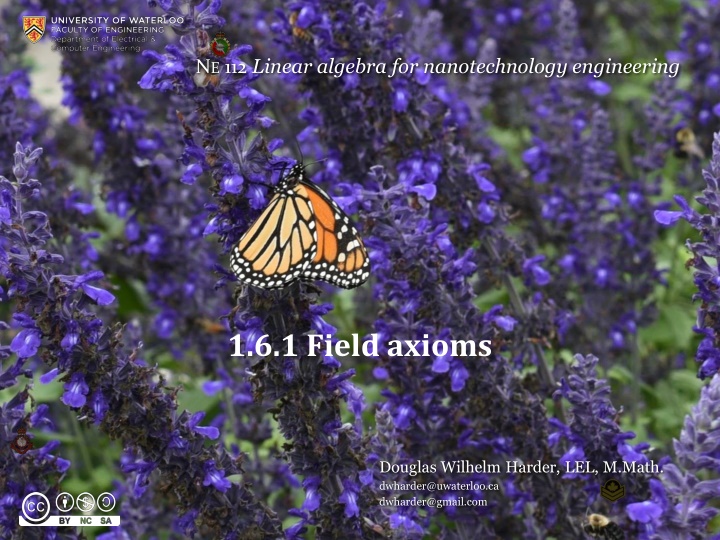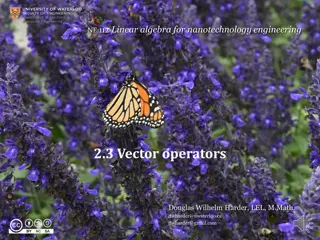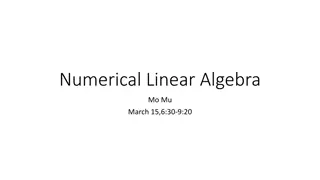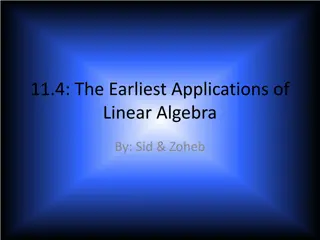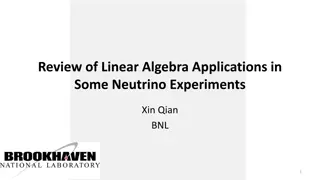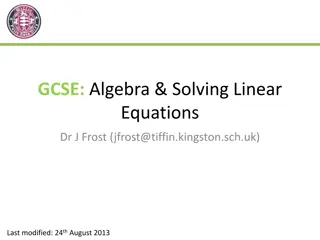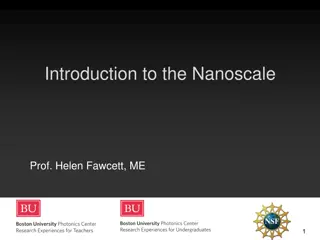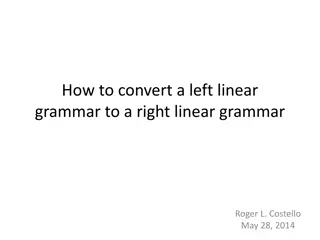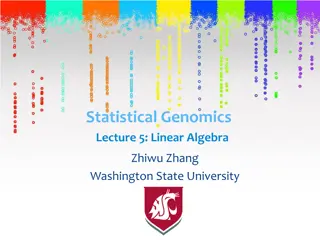Field Axioms in Linear Algebra for Nanotechnology Engineering
In this topic, the eight axioms for real numbers or fields are introduced, showing how real and rational numbers satisfy these properties. These axioms help deduce properties and theorems, with intuitive properties transferring to other fields. The significant algebraic properties of real numbers, including closure under addition and multiplication, commutative and associative properties, as well as identity and inverse axioms, are discussed. These properties form the foundation for understanding the broader concept of fields. Furthermore, the generalizations of real numbers and examples involving rational numbers are explored, demonstrating how all other properties of real numbers can be derived from these fundamental axioms.
Download Presentation

Please find below an Image/Link to download the presentation.
The content on the website is provided AS IS for your information and personal use only. It may not be sold, licensed, or shared on other websites without obtaining consent from the author.If you encounter any issues during the download, it is possible that the publisher has removed the file from their server.
You are allowed to download the files provided on this website for personal or commercial use, subject to the condition that they are used lawfully. All files are the property of their respective owners.
The content on the website is provided AS IS for your information and personal use only. It may not be sold, licensed, or shared on other websites without obtaining consent from the author.
E N D
Presentation Transcript
NE 112 Linear algebra for nanotechnology engineering 1.6.1 Field axioms Douglas Wilhelm Harder, LEL, M.Math. dwharder@uwaterloo.ca dwharder@gmail.com
Field axioms Introduction In this topic, we will Introduce the eight axioms for real numbers or fields Observer that real and rational numbers satisfy these properties See other fields Deduce properties or theorems from these axioms Gain an understanding that intuitive properties transfer 2
Field axioms Properties of the real numbers The significant algebraic properties the reals are: 1. The sum or product of two real numbers is still real I.e., they are closed under addition and multiplication 2. Addition and multiplication are commutative, + = + = and 3. Addition and multiplication are associative : ( ) ( + + = + ) ( ) ( ) + = and 4. Multiplication distributes over addition ( ) + = + 3
Field axioms Properties of the real numbers The identity and inverse axioms include: 5. There is an additive identity0 that satisfies 0 + = for all real numbers Every real has an additive inverse such that + 6. ( ) = 0 7. There is a multiplicative identity 1 that satisfies 1 = for all real numbers Every non-zero real number has a multiplicative inverse such that 1 8. 1 = 1 4
Field axioms Generalizations of the real numbers Any set of numbers with an addition and multiplication that satisfy these numbers is called a field These are called the field axioms You are already familiar with these Important concept: All other properties of the real numbers can be deduced from these eight axioms 5
Field axioms Other fields The rational numbers form a field: The sum or product of two rational numbers is still rational The other algebraic properties also hold The additive inverses of is n m m n m n n m The multiplicative inverse of when n 0 is 6
Field axioms Other examples Here is another: All numbers of the form where p and q are rational p + 2 q + 3 2 2 5 2 5 7 5 5 2 + = + 1 2 4 2 2 E.g., 3 2 58 5 17 5 + = 1 2 4 2 2 + + 3 2 3 2 3 7 = 1 2 1 2 0 3 2 2 7 = 1 2 2 1 3 2 3 2 3 2 + + 1 2 1 2 1 3 2 2 7 3 7 = = 2 7 2 + 1 2 1 2 7
Field axioms Other examples One field critical to cryptography: The integers 0, 1, 2, , p 1 where p is prime and addition and multiplication is modulo p Only keep the remainder when the result is divided by p When p = 5, we have the following tables: + 0 1 2 3 4 0 1 2 3 4 0 0 1 2 3 4 0 0 0 0 0 0 1 1 2 3 4 0 1 0 1 2 3 4 2 2 3 4 0 1 2 0 2 4 1 3 3 3 4 0 1 2 3 0 3 1 4 2 4 4 0 1 2 3 4 0 4 3 2 1 8
Field axioms Other non-examples Some common collections are not fields The non-negative real numbers All axioms are satisfied except the existence of additive inverses There is no non-negative real x such that 3 + x = 0 The integers All axioms satisfied except existence of multiplicative inverses There is no integer n such that 3n = 1 The irrationals The irrationals are not closed under addition or multiplication: ( 2 2 ) and + = = 0 2 2 2 9
Field axioms Other non-examples Consider the following: The integers 0, 1, 2, , n 1 where n is not prime and addition and multiplication is modulo n When n = 6, we have the following tables: + 0 1 2 3 4 5 0 1 2 3 4 5 0 0 1 2 3 4 5 0 0 0 0 0 0 0 1 1 2 3 4 5 0 1 0 1 2 3 4 5 2 2 3 4 5 1 1 2 0 2 4 0 2 4 3 3 4 5 1 2 2 3 0 3 0 3 0 3 4 4 5 1 2 3 3 4 0 4 2 0 4 2 5 5 0 1 2 3 4 5 0 5 4 3 2 1 10
Field axioms Other properties of fields Properties or theorems can be derived from these axioms Theorem: Proof: 0 0 because addition is commutative = because 0 + = + = + + = is an axiom 0 But if a = b and b = c, it follows that a = c. Therefore, . 0 + = QED 11
Field axioms Other properties of fields Properties or theorems can be derived from these axioms Theorem: There is only one 0 number Proof: Assume there are 0 and Z, both having the property that and Thus, 0 0 because = from the previous theorem that 0 Z Z + + = = is an axiom Z + = Z 0 = + + = Therefore, 0 = Z. QED 12
Field axioms Other properties of fields Properties or theorems can be derived from these axioms Theorem: Proof: The inverse of 1 must satisfy . Multiply both sides by : ( ( ( ( by the property of the id = ( = ( ) 1 = 1 ( ) 1 1 = 1 1 ) ( ) 1 = 1 1 1 )( ) 1 = 1 1 1 by applying commutativity and associativity ) 1 = 1 1 by the properties of the identity and the inverse ) 1 1 entity ) 1 1 QED Thus, . 13
Field axioms Why the axiomatic approach? We use this approach because if any set of numbers with an appropriately defined addition and multiplication satisfies all the eight field conditions, then all theorems must apply 14
Field axioms Some definitions def = The notation says a is equal to b by definition We can define: a b def = ( ) + def = = 1 We also define def = ( ( ) + + + ) + def = If there is no chance for ambiguity def = 15
Field axioms Why the axiomatic approach? We also define integer exponentiation: = 1 = n 0 0 0 n n n 0 1 0 0 0 n n n def = def = n n 1 a 0 + 1 1 n undefined With this, we use BE[DM][AS] to simplify our expressions Evaluate anything inside brackets first Then exponentiation Then division or multiplication left-to-right Then addition or subtraction left-to-right 16
Field axioms Why the axiomatic approach? ( ) 1 )( = ) 1 = Question: Is when neither are 0? Proof: First, . Next, multiply both sides by : 1 1 ( 1 1 ( ) ( )( ) 1 = 1 1 1 ( ( )( )( )( ( ) ) ) ) ) 1 = 1 1 ( ) 1 = 1 1 ( 1 = 1 1 ( 1 = 1 17
Field axioms Why the axiomatic approach? 1 Next, multiply both sides by : ( ) ( )( ) 1 = 1 1 1 ( ) ) ) 1 = 1 1 1 ( ( 1 = 1 1 = ( ) 1 = 1 1 QED Therefore . The inverse of a product is the product of the inverses Important: this depends on commutativity: = 18
Field axioms Why the axiomatic approach? + 1 = Question: is ? 1 1 + 1 1 + ( ) 1 = = + 1 1 Proof: First, . 1 1 1 1 + 19
Field axioms Why the axiomatic approach? Next, ( ) ( ) 1 1 + = + 1 1 1 1 1 ( ( )( ) 1 ( )( ( ( ( ( ( ) ) ( )( ) ) 1 = + 1 1 ) ) 1 ) ( 1 = + 1 1 ) ) ) ) 1 ( ) ( = + 1 1 ) ) 1 ( ( ) ( ) ( ( ( = + 1 1 1 = + 1 1 ) ( ) ( ) 1 ( ( ( ) )( )( = + 1 1 ) 1 = + 1 1 ) ( )( ) 1 1 = + = + 20
Field axioms Why the axiomatic approach? + 1 Thus, . ( 1 1 ) 1 ( )( ) 1 = + = + = 1 1 QED + This is true for all fields: the reals, the rationals, and any other set of numbers with two operations that satisfies the field axioms 21
Field axioms Why the axiomatic approach? Next, we will introduce complex numbers Complex numbers are a field Just like the reals and the rationals All the properties you re familiar with for reals and rationals apply to complex numbers, too! 22
Field axioms Why the axiomatic approach? Which do you prefer? ( ( ( ) ) ) ( ) = 1 = = ( ( ( ) ) ) = 1 = 1 ( ( ( ( ) ) = 1 You are already familiar with these properties You should be as comfortable with complex numbers as you are with the reals ( ) = 1 ) ) = = = 1 1 23
Field axioms Why the axiomatic approach? Important: this is only true because = = = For matrices, we will see that ABCB 1 AC, at least in general For matrices, BC CB, at least in general Don t assume matrices work exactly like real numbers 24
Field axioms Quick review Colloquially, you already know the field axioms: 1. The sum or product of two real numbers is a real number 2. You can add n real numbers in any order 3. You can multiply n real numbers in any order 4. Multiplication distributes over addition: ( + ) = + 5. 0 added to any real number leaves that number unchanged 6. 1 multiplied by any real number leaves that number unchanged 7. Given a real number x, x + ( x) = 0 8. Given a non-zero real number x, x x 1 = 1 25
Field axioms Important take-aways All properties you know can be derived from a very small set of specific properties or axioms All properties you know also apply to any other system that satisfy those same axioms Complex numbers satisfy these axioms If any system does not satisfy even one axiom, then none of the established theorems or subsequent properties apply Vectors cannot be multiplied Square matrices can be multiplied, but in general AB BA 26
Field axioms Summary In this topic, we introduced the axioms for fields Eight specific properties The real and rational numbers satisfy these properties From these we deduced a number of theorems Theorems are true in all systems satisfying these axioms All these properties will also hold for complex numbers You will be as comfortable with complex numbers as you currently are with real numbers 27
Field axioms References [1] [2] https://en.wikipedia.org/wiki/Field_(mathematics) http://www.math.ubc.ca/~feldman/m320/fields.pdf 28
Field axioms Acknowledgments Mariah De Torres and Sherry Elizabeth Robinson. 29
Field axioms Colophon These slides were prepared using the Cambria typeface. Mathematical equations use Times New Roman, and source code is presented using Consolas. The photographs of flowers and a monarch butter appearing on the title slide and accenting the top of each other slide were taken at the Royal Botanical Gardens in October of 2017 by Douglas Wilhelm Harder. Please see https://www.rbg.ca/ for more information. 30
Field axioms Disclaimer These slides are provided for the NE 112 Linear algebra for nanotechnology engineering course taught at the University of Waterloo. The material in it reflects the authors best judgment in light of the information available to them at the time of preparation. Any reliance on these course slides by any party for any other purpose are the responsibility of such parties. The authors accept no responsibility for damages, if any, suffered by any party as a result of decisions made or actions based on these course slides for any other purpose than that for which it was intended. 31
